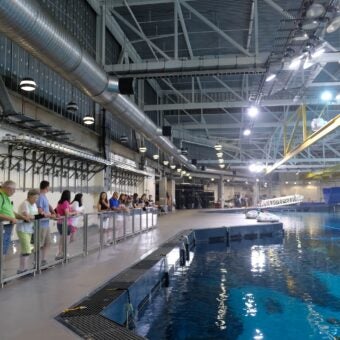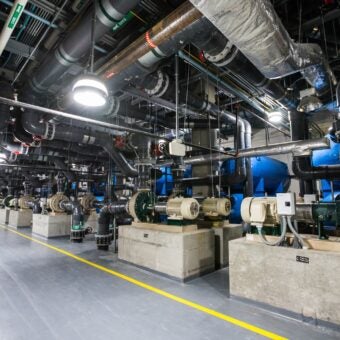-
Size
Individual polyps are 1-3mm, colonies can grow very large and weigh several tons -
Diet
Algae, zooplankton -
Range
Tropical waters around the world -
Habitat
Shallow waters that allow sunlight for growth
Physical Characteristics
- All hard corals have tentacles that provide defense, capture food and clean debris. Known as hexacorals, they have tentacles in multiples of 6 (6, 12, 24).
- Nematocysts (stinging cells) in tentacles release an often-fatal toxin into prey or threats.
- The polyp provides shelter for zooxanthellae (single-celled algae)
- The yellow to brown color of this coral is attributed to the zooxanthellae living with the polyp. Other colors are attributed to UV protecting and light regulating proteins.
- Hard exoskeleton made of calcium carbonate.
- Skeleton cup (calyx) created as lower portion of the polyp secretes calcium carbonate.
- When a polyp dies, other polyps build on top of it and continue to secrete calcium carbonate which, over time, creates a larger coral reef.
- Polyps will generally contract into its calyx when stressed and extend when feeding.
- Identical coral polyps next to each other form a structure and pattern.
- There are many types of hard coral, which are often categorized based on appearance:
- Branching (primary and secondary branches)
- Digitate (finger-like with no secondary branches)
- Table (table-like)
- Elkhorni (large, flattened branches)
- Foliase (plate-like with whorl patterns)
- Encrusting (thin layer against substrate)
- Massive/Boulder (ball-shaped ranging from very small to very large)
- Mushroom (resembles a mushroom top)
Animal Fact
Aquarists at Georgia Aquarium propagate and cultivate coral in an aquaculture system; the coral is then transplanted to the Aquarium's live reef wall located in Tropical Diver.
Diet / Feeding
- Polyp receives nutrients by:
- Mutualistic zooxanthellae receive water and carbon dioxide from the polyp, photosynthesizing the latter into oxygen, carbohydrates and lipids.
- Filtering food from water with its tentacles, capturing food by using stinging nematocysts.
- The stomach has one opening – the mouth. It is surrounded by tentacles that capture food. Food enters and leaves the mouth once it has been digested.
- Filter feeds predominantly at night.
Range / Habitat
- Reef-building hard corals generally require temperatures ranging from 73.4º to 84.2º Fahrenheit (23-29º C) but no colder than 64.4ᵒ Fahrenheit (18º C).
- No deeper than approximately 230 feet (70 m) for sunlight, which is required for photosynthesis to occur.
- Specific salinity levels as well as clear water with little sedimentation to allow for feeding and sunlight penetration are needed for optimal growth.
Reproduction & Growth
Asexual reproduction
- Budding: new polyps develop once the parent polyp grows to a certain size and then divides.
- Fragmentation: a new colony forms from a broken-off portion of an established colony. The success of this genetically identical colony depends on the growth conditions to which it is exposed.
- Occurs frequently in the wild, especially with branching coral species as they break apart with passing storms and heavy wave action.
Sexual reproduction
- Broadcast spawning:
- Occurs in about 75% of hard coral species.
- Corals can be either gonochoric (separate sexes) or hermaphrodites (having both male and female sex organs). Typically corals that are hermaphrodites cannot self-fertilize, so gametes of two distinct genotypes need to be present for fertilization to be successful.
- Female and male gametes (egg and sperm) are released into the water column in great numbers and cover a vast geographic area.
- Buoyant, they float towards the surface. In species that are hermaphrodites, the egg/sperm bundles break apart in the wave action.
- Egg and sperm will meet and form larva (planula).
- Depending on the coral species, planulae either start swimming immediately or drift as they need several days for development. Once the coral planulae are swimming they use various settlement cues to find a suitable location to call their home.
- Biotic (living) cues include coralline algae, bacterial films
- Abiotic (non-living) cues include light levels
- Timing is crucial. The synchronized event is believed to be the response to environmental cues (i.e. temperature, temperature change, day length, lunar cues).
- Despite the distance, a spawning event for any given species of coral will occur at one time.
- It is possible for a species to spawn for one or a few nights each year.
- Brooding:
- Occurs in about 25% of hard coral species.
- Only male gametes are released and are not buoyant, greatly reducing the distance it travels.
- If the waves or current bring the male gamete to the female polyp, it is taken in by the female for fertilization.
- Once developed, the larva (planula) is released through the female polyp’s mouth and able to find a hard substrate (surface) to attach itself to.
Conservation Status
- Threats include overfishing or destructive fishing practices, predation, sedimentation, pollution, disease, rising water temperature (possibly climate change), ocean acidification and powerful waves caused by hurricanes or cyclones.
- Rising temperatures that exceed the coral’s preferred temperature can lead to coral bleaching. This occurs when the polyp loses zooxanthellae and dies off. Corals typically do not lose all zooxanthellae when bleached and can potentially recover given the right situation. In addition to a reduction of zooxanthellae bleaching also results in a reduced amount of pigment in the corals. Corals can bleach due to a number of other stressors in addition to excessive temps, although excessive temps are typically to blame in the wild.
- While oceans are absorbing and bearing a large brunt and absorbing excess carbon dioxide in the atmosphere (as much as 30% of the total), the result is acidification at an accelerated rate.
- Corals are not adapted to the current, increased rate of ocean acidification and face long-term detrimental effects.
- About 60% of the world’s coral reefs are at risk (as of 2011).
Georgia Aquarium Conservation Role
- Georgia Aquarium is a participant and one of the organizers of the SECORE (SExual COral REproduction) workshop that occurs in Curacao. This organization is a non-profit initiative of public aquariums and coral scientists to create an international network of experts in coral reef conservation. The mission is to develop sustainable techniques in sexual coral reproduction and use these techniques in coral restoration efforts around the world. The team works to collect coral gametes, including Acropora palmata and Acropora cervicornis, fertilize, settle, and grow the larvae for future transplantation onto the reef.
- Since 2010, Georgia Aquarium has been working in partnership with the Coral Restoration Foundation (CRF) in the Upper Florida Keys to help to restore staghorn (Acropora cervicornis) and elkhorn (Acropora palmata) corals using ocean-based aquaculture nurseries and transplantation methodologies. Georgia Aquarium sponsors a section of Molasses Reef, near Key Largo, and sends a team out to maintain and restore this site several times every year.
Additional Information
- Coral has been around for a half billion years.
- Coral reefs cover less than one percent of the ocean floor, however, they support about 25% of all ocean life.
- There are also deep-water/cold-water corals:
- There are stony varieties in deep water ranging to 6561 feet (2000 m).
Georgia Aquarium coral reef has grown through
- Propagation- aquarists cultivate and transplant coral from an aquaculture system to the reef wall in SS2.
- GAQ aquarists employ assisted fragmentation as the primary form of culture and reproduction of our coral collection. Corals are broken into pieces. Fragments are temporarily attached to rocks using super glue, two-part epoxy or monofilament. A few days to weeks later they encrust over the attachment point and become mini coral clones of the parent colony.
- Sexual reproduction in brooding coral species has been successful in an aquarium setting. Because spawning occurs year round and the larvae are able to settle shortly after release (and therefore not get destroyed by an aquarium’s filtration system), the aquarium environment allows brooding species to proliferate with this reproductive method.
- Pocillopora damicornis, Tubastraea coccinea and Favia fragum have all successfully sexually reproduced at Georgia Aquarium.
- Acquisition from other zoological facilities.
- Confiscations made by U.S. Fish and Wildlife.
Sources
- http://oceanservice.noaa.gov/
- http://coris.noaa.gov/about/deep/
- www3.aims.gov.au/docs/publications/waypoint/002/headlines-04.html
- http://www.noaa.gov/features/economic_0708/coralreefs.html
- http://coris.noaa.gov/about/hazards/
- http://coralreef.noaa.gov/aboutcorals/coral101/polypcolony/
- http://ccma.nos.noaa.gov/ecosystems/coralreef/



